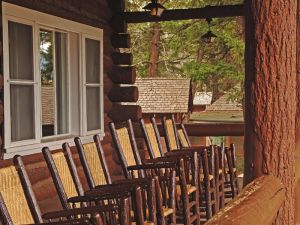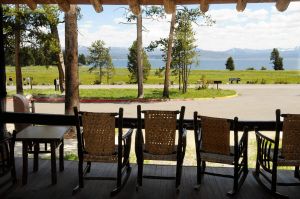Celebrating Two Iconic Park Lodges
Three years of COVID and last year’s summer flood had a tremendous impact on Yellowstone’s hospitality operations. Among other losses, we sacrificed gathering to celebrate landmarks and milestones. We, who love Yellowstone’s human history, watched a couple of anniversaries quietly go by.
Roosevelt Lodge

Embracing the spirit of the West, this rustic lodge opened in 1920 on the site of one of the park’s Wylie Camping Company tent facilities. Bozeman School teacher and principal William Wallace Wylie guided his first group of tourists through the park in 1880. Operating from his ranch in Gallatin Canyon, he led visitors on multi-day trips in horse-drawn vehicles beginning in 1892. Wylie’s wranglers broke camp daily, setting up tents in different locations nightly. Wylie sold his operation in 1905, but his successors continued using his name. New owners were allowed to construct wooden platforms for the tents, and the word “Permanent” was added to the Wylie name.
The manager of Camp Roosevelt in 1906 promoted the tent facility by pointing out the large Douglas fir under which the President had camped during his visit to the park in 1903. Never mind that TR actually camped about 3 miles away near the former Tower Soldier Station, just west of Calcite Springs Overlook.
Creating a connection to a popular public figure was good for business!
When the newly created National Park Service took over administration in 1916, the Wylie Permanent Camping Company was required to merge with several other independent camping companies to become the Yellowstone Park Camping Company. Newly admitted automobile tourists favored these more casual locales over the more expensive “grand hotel” experience. Tents evolved into simple cabin shelters, and tent dining halls gave way to our present-day lodges – communal gathering places for food and recreation.
The idea for Roosevelt Lodge was to create the feeling of a western dude ranch. The designer of Roosevelt Lodge is lost to history – its basic log cabin construction is most likely the work of a company maintenance crew. An eclectic collection of guest cabins makes up the village — some of the cabins were built for the area as early as 1922, and some were relocated from other dismantled park lodges.
Added to the National Register of Historic Places in 1983, Roosevelt Lodge Historic District includes 130 buildings. The corral area was moved to its current location in 1982. [Thanks to Rosie Wranglers for “holding down the fort” during the past three years without a corral operation!] Recent efforts to preserve the Lodge’s historical character included relocating the parking area from the front of the building to restore the view from the porch. Other modifications include remodeling the kitchen and upgrading to thermo-pane windows.
Lake Lodge

Nestled perfectly along the shores of Yellowstone Lake, Lake Lodge is a popular spot to enjoy scenic Yellowstone Lake. It is also a former Wylie site. Bozeman architect Fred Willson began working with the Yellowstone Park Lodge and Camps Co. around 1919. His first projects were “central buildings” for Mammoth, Canyon, and Lake locations. Fred designed the large central building for Lake Camp, which opened in 1920.
Lake Lodge’s first significant celebration was the 50th anniversary of Yellowstone’s establishment in 1922. Four lodge locations hosted employee-staged theatrical presentations, songs, and dance performances depicting some aspect of park history. The play at Lake Lodge recreated President U.S. Grant signing the creation bill.
Lake Lodge was originally a rectangular building — roughly the width of the current front porch. But so many visitors flocked to this location that the lobby, dining room, and kitchen were found to be of inadequate size. Willson returned to design two “wings,” added in 1926. One wing is the Employee Recreation Hall; the other is the kitchen and dining area of Wylie’s Canteen. Lake Lodge’s Frontier Cabins replaced wooden tent platforms from 1927 through 1929, and the larger Western Cabins were built in the 1970s.
Though not celebrating a recent milestone, one more historic lodge sits in the western region of the park. The Old Faithful Lodge incorporates various periods of construction from 1913 – 1928. It was the site, not of a Wylie Camp, but another competing company – The Shaw & Powell Camping Company. [Wylie’s Old Faithful Camp was on the hillside behind you when you look at Grotto Geyser on the trail to Morning Glory Pool – now officially known as Wylie Hill]. It also houses one of the beautiful recreation halls and has hosted many notable concerts and events over the years – and continues to do so.
Take time to visit all of our historic lodges. Bring your new Yellowstone friends or visiting family to celebrate the many years of preservation efforts and enjoy the buildings as they were intended– community, sustenance, and recreation.
Ruth Quinn spends her summers conducting tours of the Old Faithful Inn and winters in the Gardiner Human Resources Office. She authored Weaver of Dreams: The Life and Architecture of Robert C. Reamer and co-authored Horses, Hotels, and Hospitality: Harry W. Child’s Epic Vision for Yellowstone. Ruth also enjoys hiking, the Playmill Theater, and researching/sharing Yellowstone’s tourism history.
Read More
- Read More